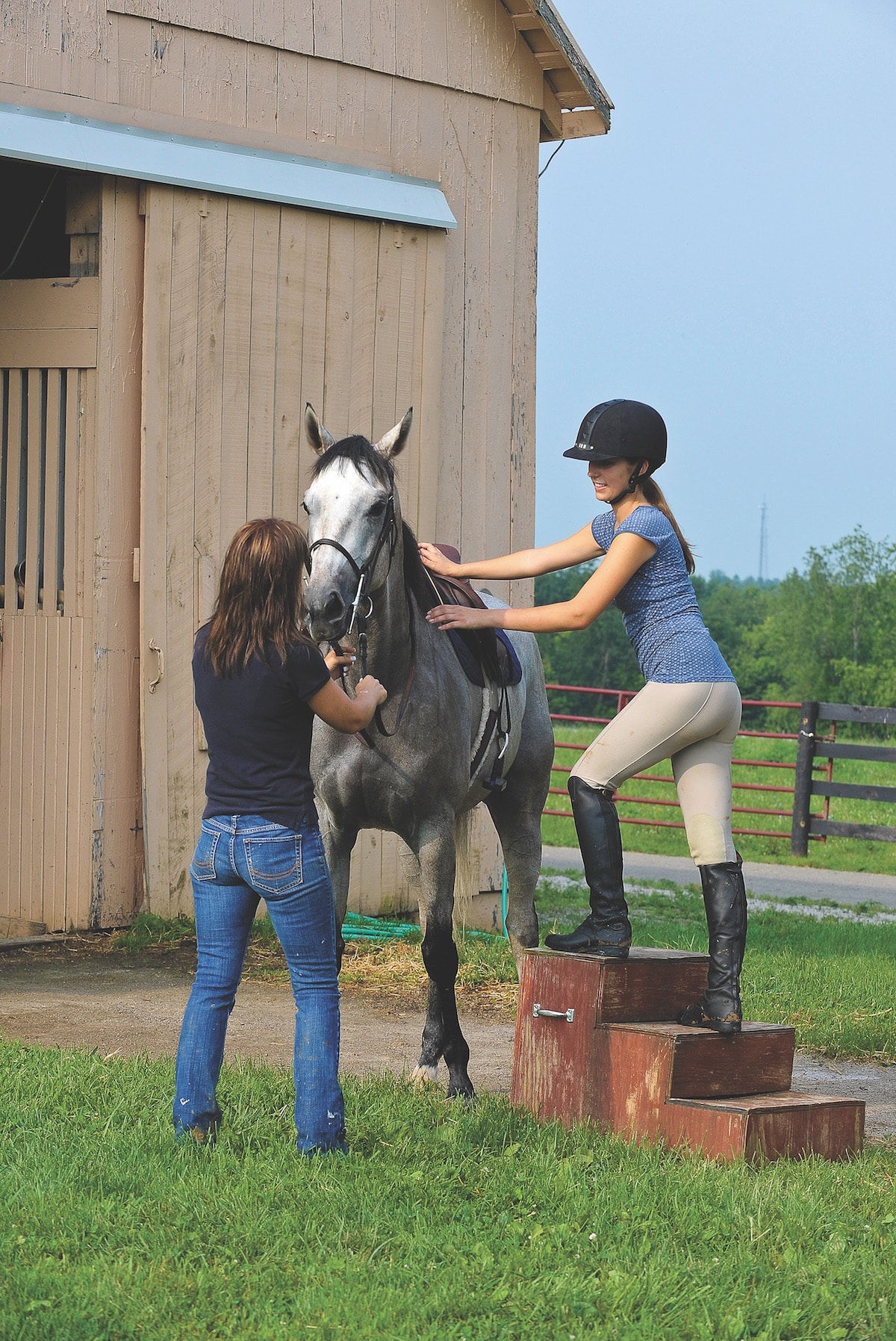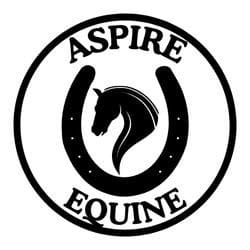Therapies and exercises that can help prevent and relieve primary back pain

A horse that hollows its back and sinks down as you mount might be showing one of the many obvious and not-so-obvious signs of back pain. Courtesy Anne M Eberhardt/The Horse Staff
Does your off-track Thoroughbred: Toss his head, ears pinned and tail swishing, when you place the saddle on his back? Flinch at the tightening of the girth around his barrel? Hollow his back, sinking down as you take a seat in the saddle?
If any of the above sounds familiar, you might be aboard a “cold-backed” mount, a term used to describe a horse with a sensitive or painful back. Horses express their back pain in many ways, some of which are challenging to recognize, such as difficulty holding contact and reluctance to work, and others more conspicuous, like full-blown bucking and rearing. And while veterinarians haven’t established that OTTBs are any more likely than other horses to experience back pain, study results (Derham 2020) have shown racing Thoroughbreds to be overrepresented among kissing spines (impinging and/or overriding dorsal spinous processes) cases.
Brett Robinson, DVM, an associate veterinarian at San Dieguito Equine Group, in San Marcos, California, whose special interests include acupuncture, sports medicine and rehabilitation, echoes this observation. With experience treating Thoroughbreds both on the racetrack and in the show ring, Robinson shares guidelines for managing the cold-backed OTTB.
Identifying the Source of Pain
Pain in the back region can stem from a variety of structures, and even several at once. The vertebrae, the joints that unite those bones and the large epaxial muscles — those running along either side of the spine — and connective tissues that stabilize the horse’s topline are all susceptible to strain and injury. Injury can be in the form of, most commonly, osteoarthritis, tendinitis, desmitis (ligament inflammation), trauma, or kissing spines. But sometimes the true source of back pain isn’t in the back at all.
In 2018 Riccio and colleagues found that only 46-50% of equine back pain originates in the back, while 49-54% has its roots elsewhere in the body.
“Secondary back pain may occur as a direct result of a horse moving abnormally to protect a distal (lower) limb injury or altered movement from sacroiliac (SI) joint strain, for example,” Robinson says. “In other words, when a horse is lame, he changes the way he moves to relieve the strain on the painful limb, and the back often takes on that extra strain. Secondary back pain may also be ‘referred pain’ due to the path of a nerve that travels from the site of the injury to the back.”
Understanding Risk Factors
“I think of the horse’s back as a suspension bridge,” Robinson says, with the four limbs the connection points on the river’s bank. “If, for whatever reason, the forces are not evenly distributed between the left and right leg, this will affect the symmetry and straining of the back.”
Whether racing or performing as a sport horse, the Thoroughbred carries extra weight on his back. And how that weight “behaves” matters. Unsurprisingly, researchers have shown that the horse’s back movement changes when a saddle and rider get added to the equation. Carrying excessive weight (> 20% of the horse’s own body weight), improperly fitting tack or an imbalanced rider can contribute to back soreness.
“It really just comes down to biomechanics,” Robinson says. “If the rider is leaning to one side, it puts asymmetric pressure on the horse’s back. Likewise, an unfit or improperly conditioned horse that hollows his back is likely to end up with a strained back.
“Moving with poor posture creates a vicious cycle of weakness and pain,” she continues. “Incorrect movement intended to protect a painful area leads to muscles developing asymmetrically, creating weakness in the body, which in turn leads to further pain.”
Robinson points out that the vertebrae most commonly affected in horses with kissing spines are the thoracic vertebrae located directly under the rider’s seat (T13-T18). “That section of the spine is also where the angle of the vertebrae’s dorsal spinous processes becomes more horizontal, thereby (becoming vulnerable to) pressure in this area — pressures which are only exacerbated by an improperly fitted saddle,” she says.
Not all backs are the same, of course, and under saddle work isn’t always the sole culprit. Unfortunately, some horses are simply built in ways that predispose them to back weakness and discomfort.
“Conformation can be a secondary cause of back soreness,” says Robinson. “For example, long-backed horses are more prone to back pain. So lengthy OTTBs may require more preventive measures and maintenance to remain comfortable and pain-free throughout their second careers.”
Providing Relief
Like most ailments, the treatment protocol for back pain depends on the diagnosis. With idiopathic (no known cause) back pain, start by consulting a professional saddle fitter to ensure your tack isn’t placing undue or uneven pressure on your OTTB’s sore back.
“Saddle fit is often the first thing we evaluate when determining a tailored rehabilitation program for the horse/rider team,” Robinson says. “That’s because no matter how many back soreness treatments you invest in, their effectiveness will be limited if the saddle remains a constant source of pain.”
Once you’ve either ruled out or remedied saddle fit issues, your veterinarian might recommend different approaches and therapies to address persistent back soreness.
Medical treatment and injections might include:
■ Methocarbamol (Robaxin) for muscle pain or spasms.
■ Phenylbutazone (Bute), a non-steroidal anti-inflammatory drug, as a first step in providing relief during the initial stages of acute back pain.
■ Intra-articular injections with corticosteroids to help reduce inflammation. Vets can also inject regenerative products such as platelet-rich plasma to promote healing.
Therapeutic modalities can involve:
■ Extracorporeal shockwave therapy to help musculoskeletal injuries heal.
■ Mesotherapy to help relieve muscle spasms. These subcutaneous injections into the middle layer of skin on the back are less invasive than traditional joint injections.
■ Functional electric stimulation therapy, a type of electrotherapy that stimulates the nerves responsible for muscle function, to help strengthen back muscles, relieve muscle spasms and restore symmetry in cases of uneven muscle development.
■ Acupuncture as a method of providing pain relief.
■ Chiropractic care to correct subluxation of the vertebrae, which can interfere with muscle and nerve function and create pain.
■ Pulsed electromagnetic field (PEMF) and massage therapy, both of which can increase blood circulation — and, therefore, healing — while reducing muscle pain and tightness.
“Physical therapy modalities to address back pain can be very useful and ultimately help maintain horses in work without invasive therapies,” Robinson says. “They should always be performed by a qualified professional.”
Strengthening exercises can be useful, as well. To lengthen and strengthen the longissimus dorsi muscle (the main muscle underneath the saddle), Robinson recommends incorporating physiotherapeutic stretches into your horse’s routine. This can be accomplished using a carrot or other treat to entice your horse to stretch his neck in both directions and by performing lumbosacral lifts (hind-end tucks) aka “standing crunches.” Such stretching exercises anecdotally improve overall comfort and range of motion, says Robinson.
A proper, thorough warmup at the start of each ride is essential. When used and fitted properly, training aids such as resistance bands can encourage your horse to engage his core and help him build the correct musculature to support the topline, Robinson says.
All the therapies listed aim to resolve back pain. If your horse’s pain is secondary to lameness, however, your vet must address the primary issue first. Secondary or compensatory back pain calls for a multifaceted approach targeting all sources of discomfort or.
Take-Home Message
Keeping your OTTB comfortable and pain-free is essential for a long, successful athletic career. Any negative reaction in response to pressure over the back is worth investigating, and addressing early onset of pain will pay dividends in preserving the comfort and performance of your equine athlete.

